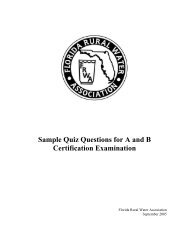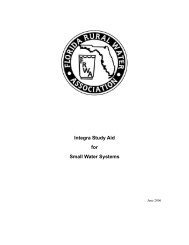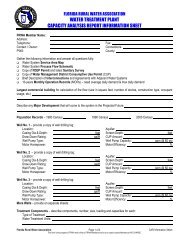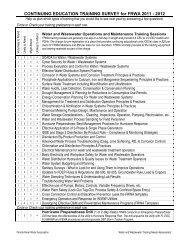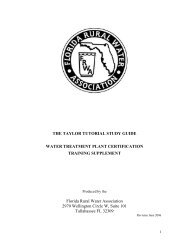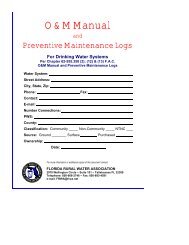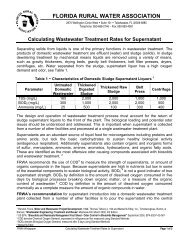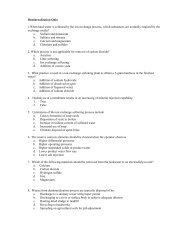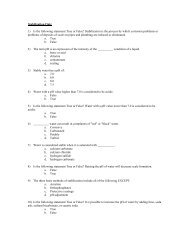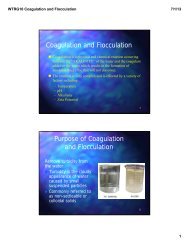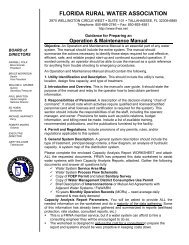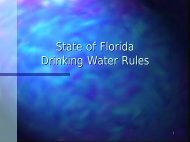1 Production of Chloramines and Chloramine ... - Save the Water
1 Production of Chloramines and Chloramine ... - Save the Water
1 Production of Chloramines and Chloramine ... - Save the Water
Create successful ePaper yourself
Turn your PDF publications into a flip-book with our unique Google optimized e-Paper software.
Underst<strong>and</strong>ing Chlorine Addition for Primary Disinfection:<br />
Disinfection by-products are formed when chlorine in <strong>the</strong> form <strong>of</strong> hypochlorous acid<br />
formed in <strong>the</strong> disinfection process is allowed to contact naturally occurring organic<br />
material. To control <strong>the</strong> production <strong>of</strong> disinfection by-products effectively, three methods<br />
can be employed: 1.) remove <strong>the</strong> organic precursors that are reactive with <strong>the</strong> chlorine,<br />
2.) decrease <strong>the</strong> amount <strong>of</strong> hypochlorous acid available for <strong>the</strong> reaction <strong>and</strong> 3.) decrease<br />
<strong>the</strong> time <strong>of</strong> contact between <strong>the</strong> organic material <strong>and</strong> <strong>the</strong> hypochlorous acid. Generally,<br />
operators will accomplish all <strong>of</strong> <strong>the</strong>se objectives by moving chlorine dosing points to<br />
locations that allow some precursor removal to occur within <strong>the</strong> plant <strong>and</strong> <strong>the</strong>n lower free<br />
chlorine concentrations to only those levels needed to meet regulatory requirements.<br />
When in-plant strategies are not successful, many systems have chosen to reduce <strong>the</strong><br />
amount <strong>of</strong> hypochlorous acid available for reaction within <strong>the</strong> distribution system by<br />
switching to chloramine as a secondary disinfectant. Free chlorine is used to provide<br />
primary disinfection <strong>and</strong> meet initial chlorine dem<strong>and</strong> <strong>and</strong> chloramine is used as <strong>the</strong><br />
secondary disinfectant, i.e. in <strong>the</strong> distribution system.<br />
It is useful to review <strong>the</strong> mechanisms <strong>of</strong> how free chlorine <strong>and</strong> chloramines are made in<br />
<strong>the</strong> disinfection process. When free chlorine (Cl 2 ) is initially added to water it goes<br />
through a series <strong>of</strong> chemical actions <strong>and</strong> eventually splits into two components. These<br />
components are hypochlorous acid (<strong>the</strong> active compound that forms <strong>the</strong> disinfection byproducts)<br />
<strong>and</strong> <strong>the</strong> hypochlorite ion.<br />
Although both hyppchlorous acid <strong>and</strong> <strong>the</strong> hypochorite ion provide disinfection, <strong>the</strong><br />
hypochorous acid that is formed is much stronger than <strong>the</strong> ion. The amount <strong>of</strong><br />
hypochlorous acid or <strong>the</strong> hypochlorite ion formed, is completely dependant on pH. These<br />
relationships are shown below:<br />
Concentration <strong>of</strong> Hypochlorous<br />
Acid <strong>and</strong> Hypchlorite Ion vs pH<br />
HOCl<br />
OCl _<br />
As can be seen from <strong>the</strong> above curve, when <strong>the</strong> pH <strong>of</strong> <strong>the</strong> water is around 7.5, a value<br />
near most Florida ground waters, <strong>the</strong> relative concentrations <strong>of</strong> hypochlorous acid is<br />
around 50%. Thus if pH is lowered, more hypochlorous acid is available <strong>and</strong> more DBPs<br />
form at a faster rate. Conversely, when pH is increased <strong>the</strong> available hypochlorous acid is<br />
2



